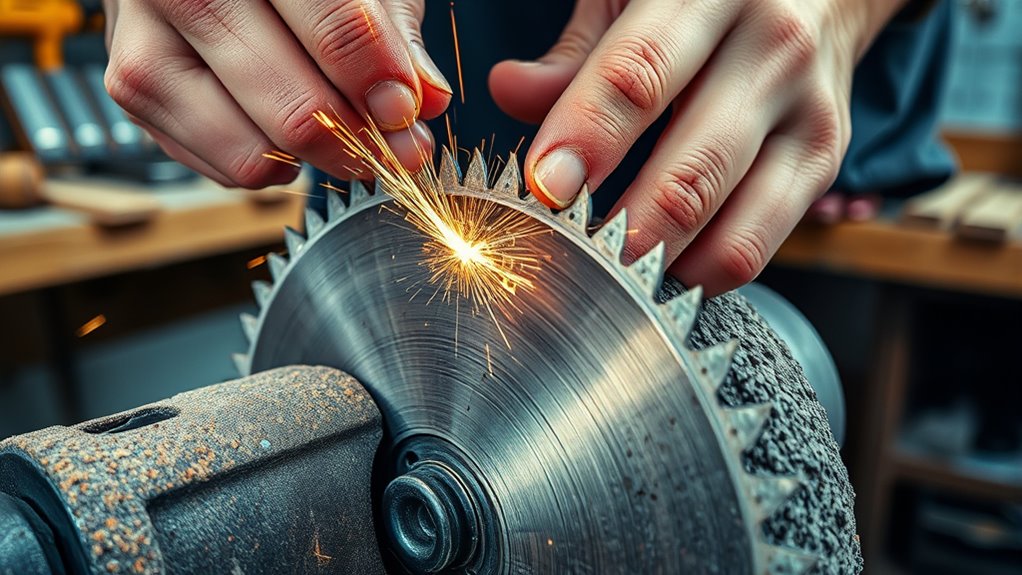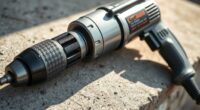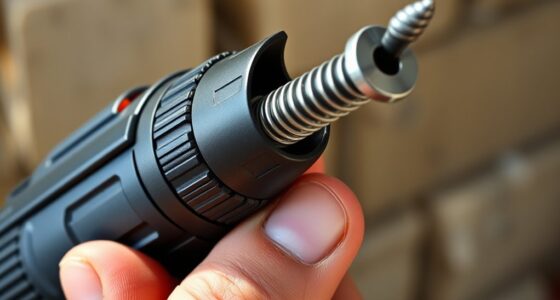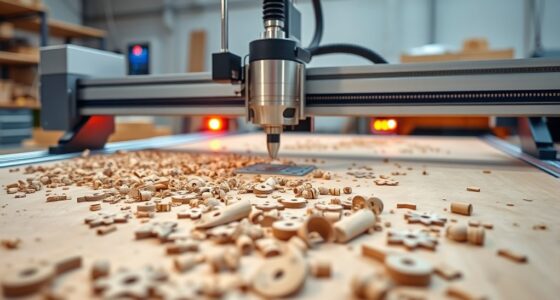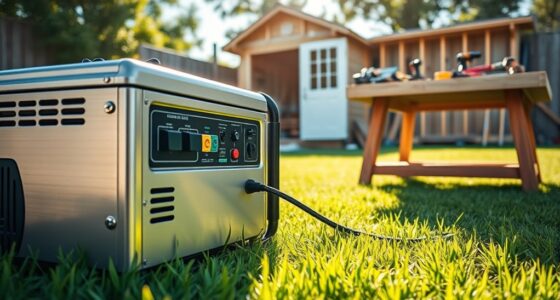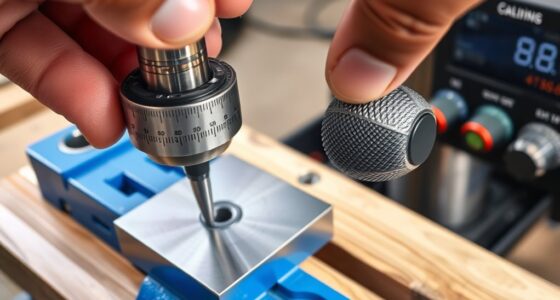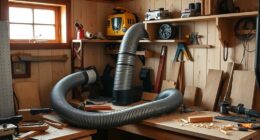To sharpen your power tool blades, first disconnect the tool and wear safety goggles and gloves. Inspect the blade for damage—replace if necessary. Secure the blade firmly and match the original bevel angle with a sharpening stone, file, or grinder for even strokes. Clean debris afterward and check for smoothness. Proper sharpening improves safety and performance. Keep exploring to discover detailed techniques and safety tips to make the process easier and more effective.
Key Takeaways
- Disconnect the power tool and secure the blade before sharpening to ensure safety.
- Inspect the blade for damage; replace if cracks or chips are present instead of sharpening.
- Match the sharpening angle to the blade’s original bevel and use appropriate tools like a grinder or file.
- Make controlled, even strokes to maintain a consistent edge and avoid over-sharpening.
- Clean the blade after sharpening, reassemble, and test for smooth, effective cutting performance.
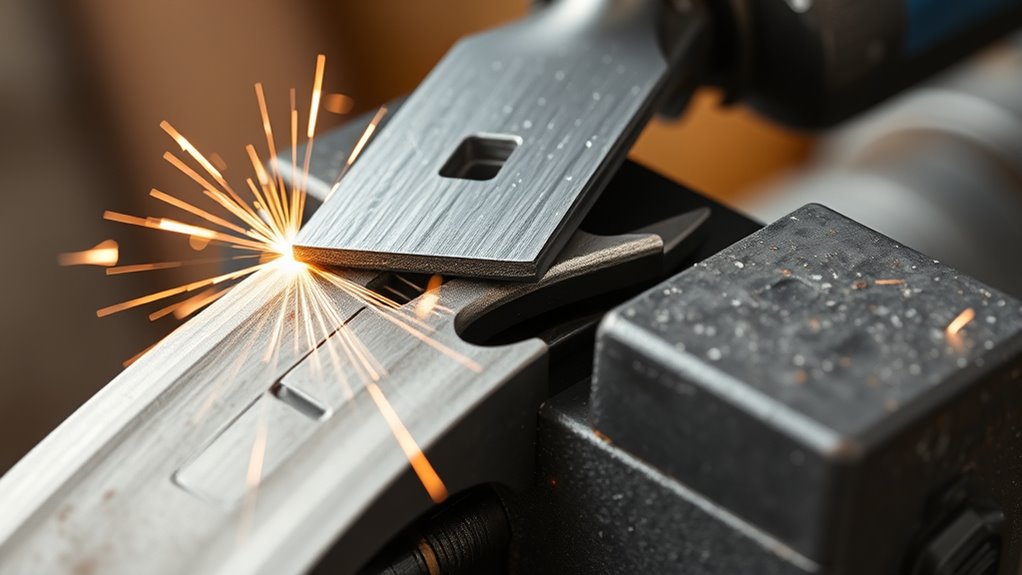
Keeping your power tool blades sharp is vital for safe, efficient, and precise cutting. When blades become dull, you risk putting more force into each cut, which increases the chances of slips or accidents. Sharp blades cut cleaner and faster, reducing strain on your tools and lowering the likelihood of accidents caused by binding or kickback. Before you begin sharpening, it’s important to review the safety precautions to protect yourself from injury. Wear safety goggles to shield your eyes from sparks or metal fragments, and gloves to prevent cuts from sharp edges. Make sure your work area is well-ventilated, especially if you’re using power grinders or sharpening tools that produce dust or fumes. Disconnect the power tool from its power source before attempting any blade maintenance or replacement to avoid accidental activation. Properly securing the blade, either by clamping it in a vice or using a dedicated fixture, guarantees stability during sharpening and prevents slips that could cause injury. If you find that the blade has significant damage, such as cracks, chips, or excessive wear, it might be safer and more cost-effective to replace the blade altogether rather than attempting to sharpen it. Blade replacement is often a straightforward process, but always follow the manufacturer’s instructions for safe removal and installation. Using the wrong tools or applying excessive force can damage your equipment or cause injury. When sharpening, aim for a consistent angle that matches the original bevel of the blade. Many blades have a specific edge angle, and maintaining this ensures peak cutting performance. Use a sharpening stone, file, or grinder suitable for your blade type, and take your time to make even, controlled strokes. Over-sharpening or uneven sharpening can lead to poor performance and increased wear. After sharpening, inspect the blade carefully for any remaining dull spots or uneven edges. Clean off any debris or metal shavings to prevent them from contaminating your workpiece or causing future issues. Regularly checking your blades and maintaining proper sharpening routines extends their lifespan, saving you money and downtime. Additionally, understanding the types of blades and their specific sharpening requirements can help you achieve optimal results and prolong blade life. Remember, if at any point you’re unsure about the condition of a blade or feel uncomfortable sharpening it yourself, consulting the manufacturer’s guidelines or seeking professional help is always the safest choice. Proper safety precautions and attentive blade maintenance not only improve your cutting results but also keep you safe during every project. Whether you choose to sharpen your blades or opt for blade replacement, always prioritize safety and follow the correct procedures to guarantee your work remains efficient and injury-free.
Frequently Asked Questions
Can I Sharpen Power Tool Blades With a Regular Handheld Grinder?
You can use a handheld grinder to sharpen power tool blades, but you need to consider blade compatibility first. Not all blades are suitable for grinding, so check the manufacturer’s instructions. When you do use a handheld grinder, ensure you match the grit and blade type to avoid damage. Carefully follow safety precautions, and work slowly to maintain the blade’s original angle and sharpness for the best results.
How Often Should I Sharpen My Power Tool Blades?
You should sharpen your power tool blades based on their blade lifespan and sharpening frequency. Typically, check them after every few uses or when you notice reduced performance or increased effort. Regular sharpening maintains cutting efficiency and prolongs blade life. Don’t wait until they are completely dull—sharpening sooner prevents damage and ensures cleaner cuts. Keep an eye on performance and sharpen as needed to maximize your blades’ effectiveness and lifespan.
What Safety Precautions Are Necessary When Sharpening Blades?
When sharpening blades, you need to prioritize safety. Always wear personal protective equipment like gloves, safety glasses, and a dust mask to protect yourself from sparks, metal shards, and dust. Guarantee your workspace safety by working in a well-ventilated area, securing the blade firmly, and keeping tools organized. Never rush, and stay focused to avoid accidents. Proper safety precautions make sharpening safer and more effective.
Can I Sharpen Blades Without Removing Them From the Tool?
Did you know that improper blade maintenance can reduce cutting efficiency by up to 50%? You can sharpen blades without removing them from your tool, but it’s not ideal. Using the right sharpening techniques while the blade stays mounted can be tricky and may compromise safety or effectiveness. For best results, remove the blade, then carefully sharpen it with a proper file or grinder, ensuring even contact for peak performance.
What Are the Signs That a Blade Needs Replacing Instead of Sharpening?
When you notice your blade’s condition declining, it might be time to replace it instead of sharpening. Signs include significant dullness, chipped or cracked edges, or uneven cuts. If you find yourself sharpening frequently without much improvement, it indicates the blade’s condition has worsened beyond simple maintenance. Remember, maintaining proper sharpening frequency extends blade life, but once damage becomes evident, replacement is the best choice for safety and efficiency.
Conclusion
Sharpening your power tool blades might seem tricky at first, but with the right technique, it’s pretty straightforward. Don’t worry if it takes a little practice—you’ll get the hang of it quickly. Remember, a sharp blade makes your cuts cleaner and your tools last longer, saving you time and money. So, go ahead and give it a try. Once you see the difference, you’ll wonder why you waited so long to sharpen your blades!
